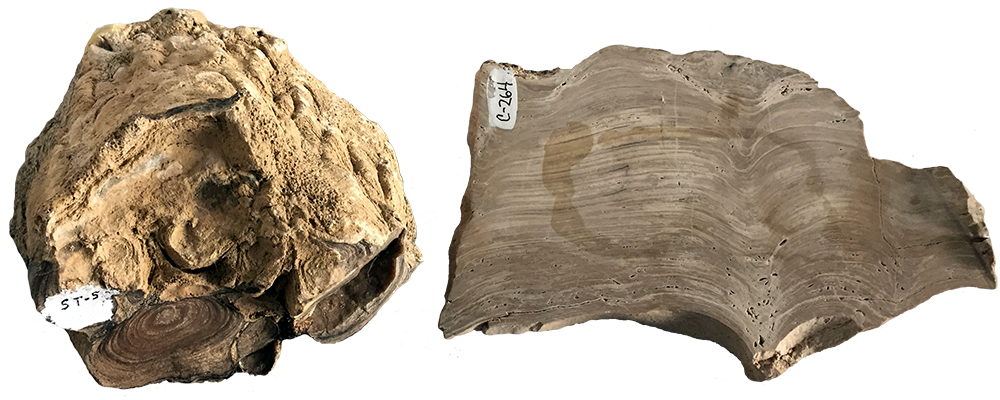
Stromatolites are layered sedimentary features that form from the growth and decay of photosynthetic microorganisms, such as cyanobacteria and sulfate-reducing bacteria. They include some of the oldest direct evidence of life on Earth and dominated the fossil record for most of Earth’s history.
Their name comes from the ancient Greek for ‘layered rock’ and reflects the most obvious stromatolite characteristic, their fine layering. These layers form from a combination of two processes. The living microorganisms can trap sediment, using adhesive secretions or tiny filaments to form ‘microbial mats’ that build up over time. However, as these microorganisms are buried by sediment or other bacteria, they die, and their decay alters surrounding water chemistry to precipitate carbonate minerals that form a solid layer beneath the living microbial mat. Hence, stromatolites are layered biochemical accretionary structures.
Stromatolites typically form in shallow, sunlit waters and can exhibit a variety of forms from simple wrinkled flat mats to complex columns or large domes to a meter or more in diameter. For most of Earth’s history, stromatolites dominated the fossil record, but with the rise of algal-feeding multicellular life forms, stromatolites became relatively rare. Stromatolite abundance peaked around 1.25 billion years ago, when it is thought soft-bodied grazing organisms arose. In our modern world, stromatolites only are found in relatively harsh environments where high currents or high salinities inhibit snails and other grazing organisms that feed on cyanobacteria. Algal mats still form in a wide variety of settings but are usually consumed by other organisms before they can become part of the fossil record.
Some stromatolite-like structures appear to have formed from abiotic (non-biological) precipitation, but the stromatolites here definitely reflect past life. More importantly, stromatolites like these have altered the evolution of Earth’s life. Cyanobacterial stromatolites were largely responsible for increased levels of free oxygen in the Earth’s oceans and atmosphere, which transformed the chemical cycling of Earth’s surface systems. Eventually, increased oxygenation even allowed the development of the more complex eukaryotic life, including the multicellular organisms that fed on stromatolites, as well as their eventual acquisition of hard parts like shells, bones, and teeth.
Hence these ancient life forms to a remarkable extent led to our present world and modern biodiversity.